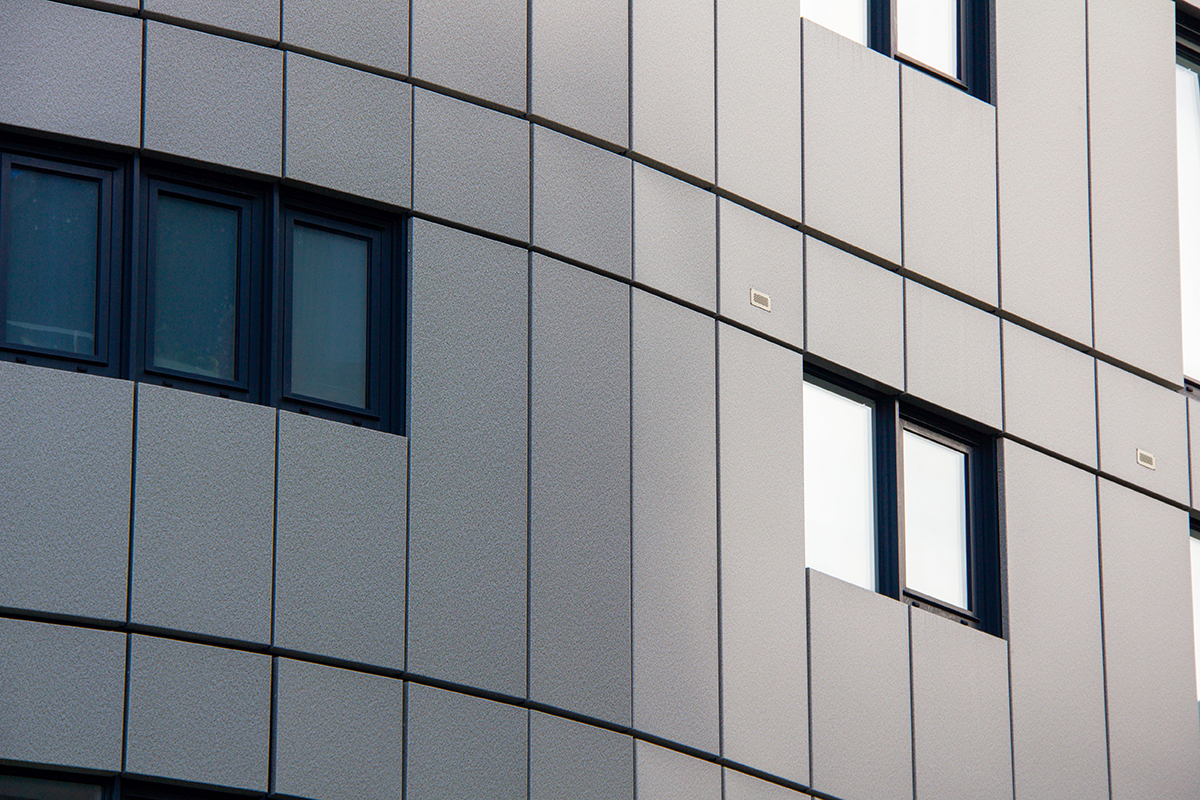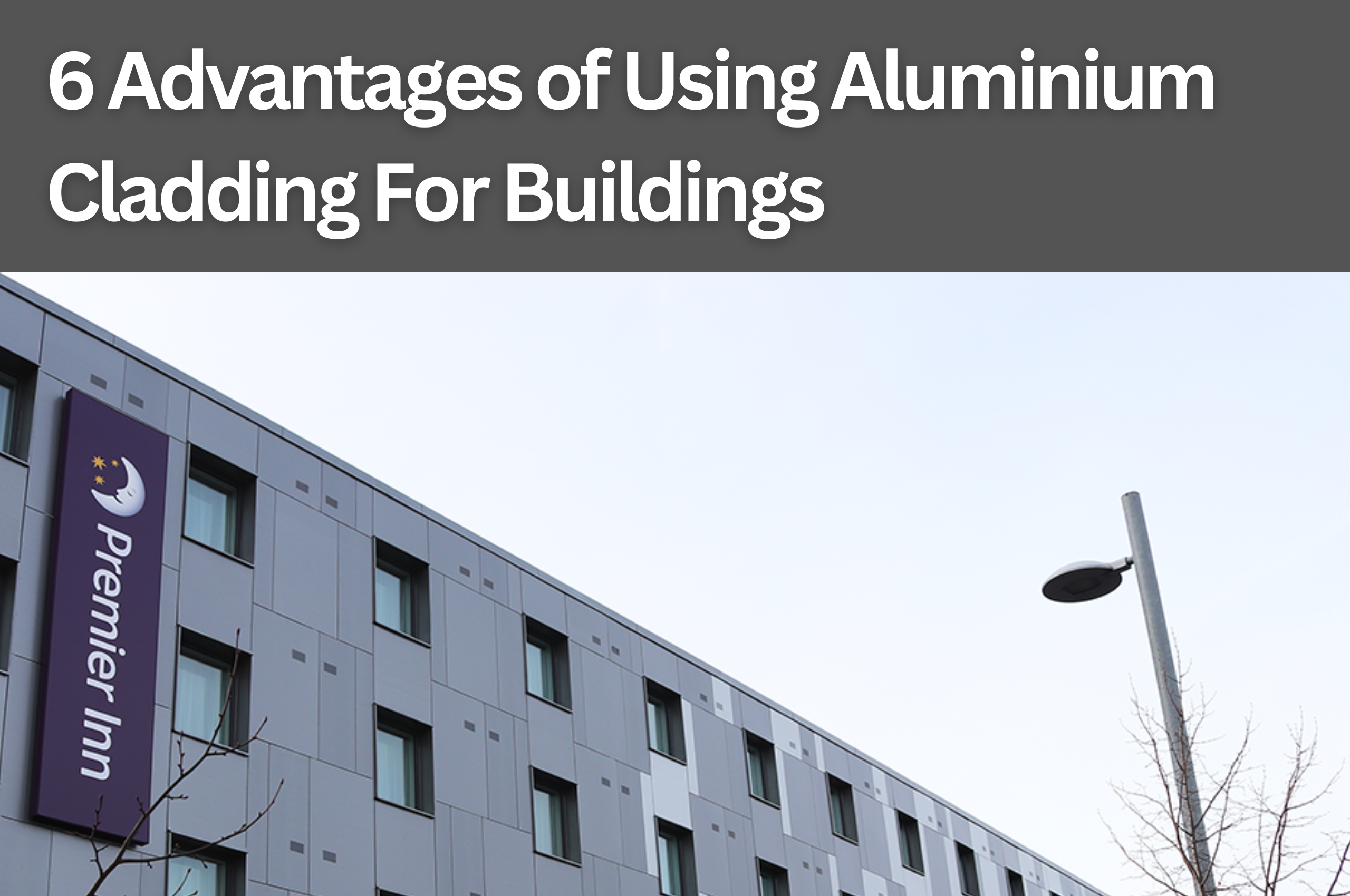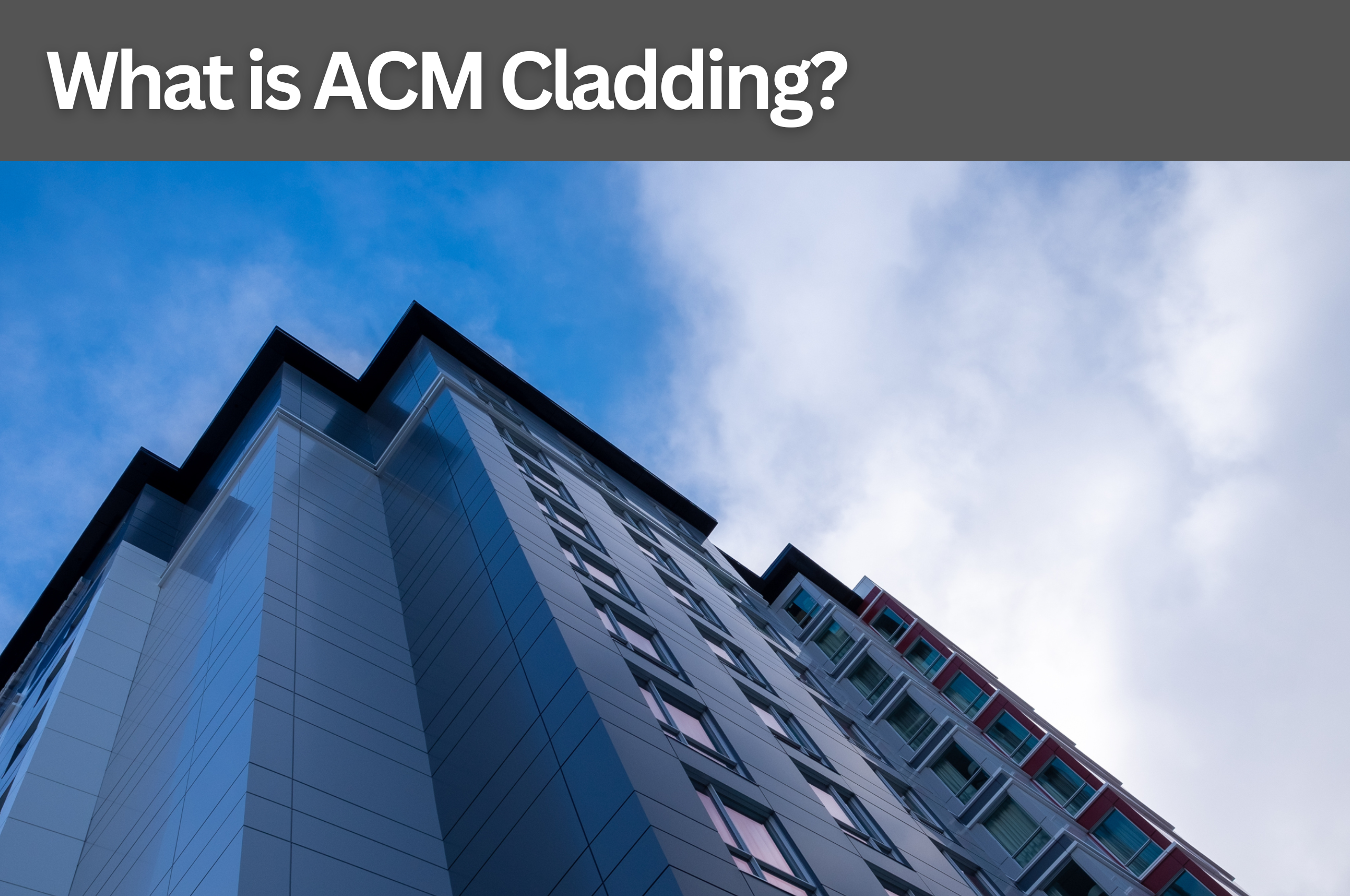Finish Facades Knowledge Base
What is an Aluminium Rainscreen Cladding System?

An aluminium rainscreen cladding system is a protective covering used in building construction
to shield structures from external elements such as rain, wind, and snow. This system consists
of lightweight, durable, and corrosion-resistant aluminium panels, or aluminium alloy panels,
that are attached to a framework, creating an air gap for ventilation and drainage. The primary
purpose of the system is to provide insulation and enhance energy efficiency while also
contributing to the aesthetic appeal of the building.
The Benefits of an Aluminium Rainscreen Cladding System
- Improved thermal performance: The aluminium cladding, combined with insulation within the
air gap enhances the building's thermal performance, often measured using U-values. - Moisture management: The system effectively manages moisture by preventing water
penetration and promoting ventilation, which reduces the risk of condensation. - Durability and low maintenance: Aluminium’s inherent resistance to corrosion leads to
increased system durability and lower long-term maintenance costs. - Effective management of moisture infiltration
- Water penetration prevention
- Improved insulation: These systems provide additional insulation, contributing to improved
energy efficiency.
The key components of this system typically include the outer cladding panel, the air gap for ventilation purposes, and an inner weather-resistant barrier designed to prevent water seepage.
Finish Facades is a reputable provider of customisable high-quality rainscreen aluminium cladding systems that cater to various design aesthetics. Our solutions enhance not only the appearance but also the durability, energy efficiency, and protection of buildings. In this article, we aim to give you all the information you need to know about Aluminium Rainscreen Cladding Systems.

Understanding the Basics of Rainscreen Cladding Systems
Rainscreen cladding systems featuring aluminium panels are a crucial component in modernbuilding construction. These systems involve the use of lightweight and corrosion-resistant aluminium panels secured to a framework. The primary purpose is to shield structures from external elements like rain, wind, and snow, while also providing insulation and enhancing energy efficiency.
This type of cladding is designed to protect buildings from external elements such as rain, wind, and snow. The outer cladding panel is typically made of durable aluminium that is resistant to corrosion.
The air gap allows for proper airflow and ventilation, preventing moisture buildup and condensation. Additionally, the inner weather-resistant barrier ensures that water does not seep into the building structure, which could cause structural issues over time.
Rainscreen aluminium cladding offers numerous benefits including improved thermal performance, better moisture management, prolonging building lifespan, reducing maintenance costs, and enhancing insulation, while enhancing a building's visual appeal, offering sleek and modern design options.
Overall, it provides a sleek and modern aesthetic while being durable, low maintenance, and energy-efficient.
Benefits of Aluminium Rainscreen Cladding
One notable advantage of aluminium rainscreen cladding is its ability to significantly enhance the thermal performance and energy efficiency of a structure. By providing an additional layer of insulation, the cladding helps to reduce heat loss during colder months and minimises heat gain in warmer climates.
One notable advantage of aluminium rainscreen cladding is its ability to significantly enhance the thermal performance and energy efficiency of a structure. It achieves this by providing an additional layer of insulation, typically with materials such as foam or mineral wool, between the cladding panels and the building's outer wall. This insulation helps to reduce heat loss during colder months, thereby improving energy efficiency by reducing the need for excessive heating. Additionally, it minimises heat gain in warmer climates, thus contributing to a more comfortable indoor environment.
This improved thermal performance leads to reduced energy consumption and lower heating and cooling costs for the building.
Furthermore, aluminium rainscreen cladding promotes better airflow and ventilation through the air gap between the panels and the building's outer wall. This active ventilation helps prevent moisture buildup and condensation within the wall assembly. Excess moisture can lead to structural damage and mould growth, so effective moisture control is critical for the long-term durability of a building.
By providing an additional protective layer against the elements, aluminium cladding extends the lifespan of a building's primary structure. Beyond its functional benefits, aluminium rainscreen cladding offers a wide range of design possibilities, enhancing the visual appeal of a building.
Overall, these benefits make aluminium rainscreen cladding a valuable choice for enhancing both the sustainability and durability of buildings while also providing aesthetic appeal.

What is the Installation Process of Rainscreen Cladding?
The installation process of rainscreen cladding involves a series of carefully planned steps to ensure proper attachment, ventilation, and weather resistance.
Firstly, the framework or support structure is installed onto the building's exterior wall. This framework provides stability for the cladding panels and allows for the creation of an air gap between the panels and the wall. The choice of materials for the framework, such as aluminium or steel, depends on factors like the building's design and environmental conditions.
Next, the outer cladding panels are attached to the framework using appropriate fasteners and fixings. These lightweight aluminium panels are often pre-fabricated with interlocking edges for easy installation.
The air gap created by the framework promotes airflow and ventilation, preventing moisture buildup and condensation.
Behind the cladding panels, an inner weather-resistant barrier is installed. This barrier is typically a membrane or material that acts as a secondary defence against water seepage into the building envelope. It helps ensure that any moisture that does reach the cladding is directed away from the underlying structure. The choice of barrier material and its installation method is crucial for long-term durability.
The installation process requires careful attention to detail in order to achieve a well-ventilated, durable, and weather-resistant rainscreen cladding system.

Types of Aluminium Rainscreen Panels
There are several different types of panels available for use in rainscreen systems, each offering unique features and benefits that can enhance the appearance and performance of a building.
One type is solid aluminium panels, which provide a sleek and modern aesthetic while offering durability and resistance to corrosion. These panels are lightweight and easy to install, making them a popular choice among architects and builders.
Another type is perforated aluminium panels, which allow for airflow and ventilation while still providing protection from the elements. These panels can be customised with various hole patterns to create visual interest or to meet specific design requirements. The level of airflowand ventilation can vary based on the perforation pattern. The choice of pattern can impact both aesthetics and functionality.
Lastly, there are composite aluminium panels, which consist of a thin layer of aluminium bonded to a non-aluminium core material such as polyethylene or fire-resistant mineral core. The FR core provides higher fire resistance, which is a critical consideration in some building applications, especially high-rise buildings or those with specific fire safety requirements. This combination offers enhanced insulation properties while maintaining the lightweight nature of
aluminium cladding.
Overall, the selection of an appropriate panel type depends on factors such as desiredaesthetics, thermal performance requirements, and budget considerations.
Applications of Rainscreen Cladding Systems
Applications of rainscreen cladding systems encompass a wide range of buildings, including residential, commercial, and institutional structures. These cladding systems offer numerous benefits such as improved thermal performance, enhanced airflow and ventilation, prolonged building lifespan, and reduced maintenance costs.
In residential applications, rainscreen cladding provides insulation and energy efficiency, and enhances the overall appearance of the building, while providing exceptional weather protection.
In commercial buildings, it adds a sleek and modern aesthetic while protecting against external elements. It helps protect against external elements, which is particularly crucial for buildings with extensive glass facades or unique architectural designs.
Institutional structures like schools or hospitals benefit from the durability and low maintenance of rainscreen cladding systems.With their ability to manage moisture and prevent water penetration, these cladding systems are
versatile in their applications across different types of buildings.
Additionally, the customisable colours and finishes of aluminium panels allow for design flexibility to suit various architectural styles.
Maintenance and Care for Aluminium Rainscreen Cladding
Maintenance and care for the aluminium rainscreen cladding involves regular inspections,
cleaning, and repairs to ensure its longevity and optimal performance.
Inspections should be conducted at least once a year to identify any damage or deterioration. This includes checking for signs of corrosion, loose or damaged panels, and gaps in the weather-resistant barrier, as well as anywhere that moisture is penetrating. More frequent inspections, such as quarterly or semi-annually, may be necessary in areas with harsh weather conditions or high pollution levels.
Cleaning is essential to remove dirt, debris, and pollutants that can accumulate on the cladding surface over time. It is recommended to use non-abrasive cleaners and soft brushes or cloths to avoid scratching the aluminium finish. The choice of cleaning agents should also consider the local environment and pollution levels.
Repairs should be promptly addressed to prevent further damage and maintain the integrity of the cladding system. This may involve replacing damaged panels, sealing gaps, or applying protective coatings as necessary.
Following these maintenance practices will help extend the lifespan of the aluminium rainscreen cladding while ensuring it continues to provide effective protection and enhance building aesthetics.

Fire Safety and Aluminium Rainscreen Cladding
Fire safety is a crucial aspect to consider when implementing an effective protective system for buildings, ensuring that potential risks are minimised and occupant safety is prioritised. When it comes to aluminium rainscreen cladding systems, fire safety measures play a significant role in maintaining the integrity of the building and protecting its occupants.
Aluminium has inherent fire-resistant properties, making it a suitable choice for cladding applications. However, it is essential to ensure that the installation follows proper fire safety protocols and regulations to maximise its effectiveness.
This includes using fire-resistant insulation materials behind the cladding panels, incorporating fire breaks within the system, and considering additional measures such as sprinkler systems or smoke detectors. Regular inspections and maintenance are also crucial to identify any potential issues or damage that could compromise the fire resistance of the cladding system.
By adhering to these guidelines, aluminium rainscreen cladding can contribute to overall fire safety in buildings while providing durability and aesthetic appeal.
Conclusion
In conclusion, an aluminium rainscreen cladding system is a vital component in building construction, providing protection against external elements and enhancing energy efficiency.
Its lightweight and durable aluminium panels offer improved thermal performance, ventilation, and moisture management.
The installation process involves attaching the panels to a framework with an air gap for ventilation. Different types of aluminium rainscreen panels are available to suit various aesthetic preferences.
Rainscreen cladding systems have diverse applications and require proper maintenance to ensure longevity. Lastly, fire safety measures, such as selecting fire-rated materials and installing fire barriers, must be considered when using aluminium rainscreen cladding systems.
Choose Finish Facades For Your Building's Aluminium Rainscreen Cladding Systems
When it comes to finding a superior and tested rainscreen cladding system for your building project, there's no need to look any further than Finish Facades. Our state-of-the-art Aluminium rainscreen cladding systems are meticulously crafted to not only meet but exceed the stringent standards of BR135 and EN 13501-1 in the UK.
Ensuring safety is our paramount concern, our cladding systems offer unparalleled fire resistance, providing a shield of protection against potential fire hazards. With Finish Facades, you can trust in our expertise to elevate your construction projects to new levels of safety and reliability. Don't compromise on the safety of your buildings - make the right choice today and join the ranks of countless satisfied clients who have placed their trust in Finish Facades.
Need more information?
To see how Finish Facades could support your next project - simply call us, or use the form below.

